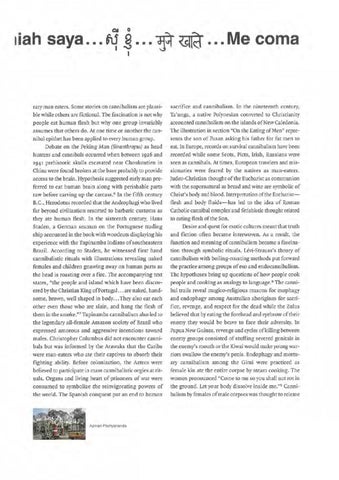c::w
o
liah saya . .. nr .§ · · · ~ ~ · · · Me coma I
rary man eaters. Some stories on cannibalism are plausible while others are fictional. The fascination is not why people eat human flesh but why one group invariably assumes that others do. At one time or another the cannibal epithet has been applied to every human group. Debate on the Peking Man (Sínanthropus) as head hunters and cannibals occurred when between I926 and I94I prehistoric skulls excavated near Choukoutien in China were found broken at the base probably to provide access to the brain. Hypothesis suggested early man preferred to eat human brain along with perishable parts raw before carving up the carcass. 6 ln the fifth century B.C., Herodotus recorded that the Androphagi who lived far beyond civilization resorted to barbaric customs as they ate human flesh. ln the sixteenth century, Hans Staden, a German seaman on the Portuguese trading ship accounted in the book with woodcuts displaying his experience with the Tupinamba lndians of southeastern Brazil. According to Staden, he witnessed first hand cannibalistic rituaIs with illustrations revealing naked females and children gnawing away on human parts as the head is roasting over a fire. The accompanying text states, "the people and island which have been discovered by the Christian King ofPortugal . . . are naked, handsome, brown, well shaped in body ... They also eat each other even those who are slain, and hang the flesh of them in the smoke."7 Tupinamba cannibalism also led to the legendary all-female Amazon society of Brazil who expressed amorous and aggressive intentions toward males. Christopher Columbus did not encounter cannibals but was informed by the Arawaks that the Caribs were man-eaters who ate their captives to absorb their fighting ability. Before colonization, the Aztecs were believed to participate in mass cannibalistic orgies at rituaIs. Organs and living heart of prisoners of war were consumed to symbolize the reinvigorating powers of the world. The Spanish conquest put an end to human
Ap inan Poshyananda
sacrifice and cannibalism. ln the nineteenth century, Ta'unga, a native Polynesian converted to Christianity accounted cannibalism on the islands ofNew Caledonia. The illustration in section "On the Eating ofMen" represents the son of Pasan asking his father for fat men to eat. ln Europe, records on survival cannibalism have been recorded while some Scots, Picts, lrish, Russians were seen as cannibals. At times, European travelers and missionaries were feared by the natives as man-eaters . Judeo-Christian thought ofthe Eucharist as communion with the supernatural as bread and wine are symbolic of Christ's body and blood. lnterpretation ofthe Eucharistflesh and body fluids-has led to the idea of Roman Catholic cannibal complex and fetishistic thought related to eating flesh of the Son. Desire and quest for exotic cultures meant that truth and fiction often became interwoven. As a result, the function and meaning of cannibalism became a fascination through symbolic rituaIs. Lévi-Strauss's theory of cannibalism with boiling-roasting methods put forward the practice among groups of exo and endocannibalism. The hypotheses bring up questions ofhow people cook people and cooking as analogy to language. 8 The cannibal trails reveal magico-religious reasons for exophagy and endophagy among Australian aborigines for sacrifice, revenge, and respect for the dead while the Zulus believed that by eating the forehead and eyebrow of their enemy they would be brave to face their adversity. ln Papua New Guinea, revenge and cycles ofkilling between enemy groups consisted of stuffing severed genitaIs in the enemy's mouth or the Kiwai would make young warriors swallow the enemy's penis. Endophagy and mortuary cannibalism among the Gimi were practiced as female kin ate the entire corpse by steam cooking. The women pronounced "Come to me so you shall not rot in the ground. Let your body dissolve inside me."9 Cannibalism by females of male corpses was thought to release
